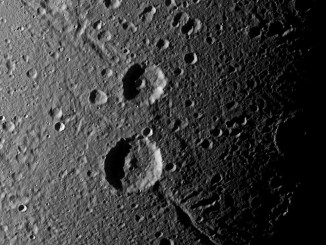
Saturn’s moon Tethys appears to float between two sets of rings in this view from NASA’s Cassini spacecraft, but it’s just a trick of geometry. The rings, which are seen nearly edge-on, are the dark bands above Tethys, while their curving shadows paint the planet at the bottom of the image.
Tethys (1,062 kilometres or 660 miles across) has a surface composed mostly of water ice, much like Saturn’s rings. Water ice dominates the icy surfaces in the the far reaches of our Solar System, but ammonia and methane ices also can be found.
The image was taken in visible light with the Cassini spacecraft wide-angle camera on November 23, 2015. North on Tethys is up. The view was obtained at a distance of approximately 65,000 kilometres (40,000 miles) from Tethys. Image scale is 4 kilometres (2.4 miles) per pixel.
Saturn: Exploring the Ringed Planet
Find out more about Saturn and its moons in this 196-page special edition from Astronomy Now. Order online.




